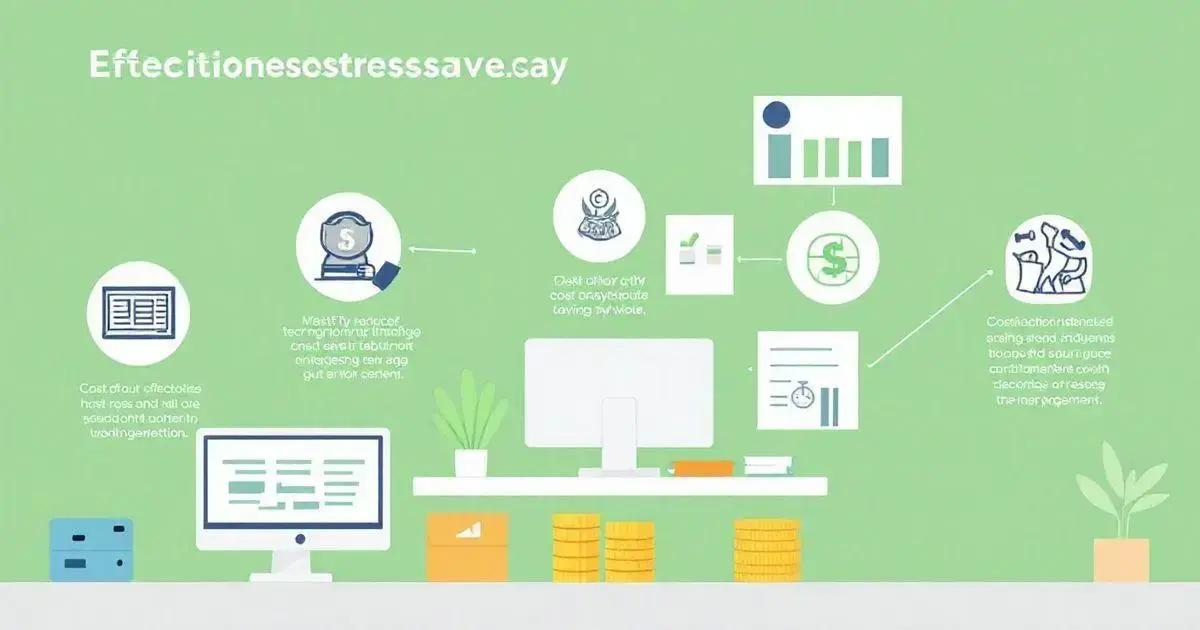Are you searching for effective cost-saving strategies to enhance your business’s profitability? In today’s competitive market, cutting costs without sacrificing value is more important than ever. Many businesses are seeking smarter ways to manage their budgets while continuing to deliver great service.
Implementing Effective Cost-Saving measures can help streamline operations, eliminate waste, and optimise resource use. From renegotiating vendor contracts to adopting energy-efficient technologies, there are countless ways to lower expenses and boost long-term sustainability.
If you’re ready to discover Effective Cost-Saving techniques that truly make a difference, this guide is for you. Continue reading to explore actionable ideas that can help your business thrive even during uncertain economic times.
Understanding Cost-Saving Strategies
Understanding how to implement Effective Cost-Saving strategies is essential for maintaining financial health in any business. These strategies focus on reducing unnecessary expenses while preserving the quality of products or services. By examining every area of your operation, you can find small changes that lead to significant savings over time.
One key to Effective Cost-Saving is evaluating current processes and identifying inefficiencies. This could mean automating repetitive tasks, switching to more affordable suppliers, or reducing energy consumption. Even minor adjustments, when done consistently, contribute to better overall performance and profitability.
To fully benefit from Effective Cost-Saving, businesses must create a culture of cost awareness. Encourage employees to suggest ways to cut waste and optimise spending. With a proactive approach, cost-saving becomes part of daily operations—fueling long-term growth and stability.
Analyzing Your Business Expenses

Analyzing your business expenses is a critical step in implementing effective cost-saving strategies. By understanding where your money goes, you can identify areas for improvement.
Gathering Expense Data
Begin by collecting all relevant financial documents, such as invoices, receipts, and bank statements. This will provide a comprehensive view of your expenses over a set period, typically a month or a quarter.
Categorising Expenses
Organise expenses into categories like:
- Fixed Expenses: These are costs that remain constant, such as rent and salaries.
- Variable Expenses: Costs that fluctuate include utilities and materials.
- Discretionary Expenses: These are non-essential costs like entertainment and office snacks.
Identifying Trends
After categorisation, look for trends in your spending. Are there specific categories where spending has increased significantly? This analysis might reveal opportunities to cut costs or optimise spending.
Benchmarking Against Industry Standards
Comparing your expenses with industry benchmarks can help you understand if you’re overspending in certain areas. Research industry standards to see how your business stacks up.
Using Financial Software
Consider implementing financial software to assist with tracking and analysing expenses. Many tools provide visual reports and alerts that make it easier to stay on top of finances.
By carefully analyzing your business expenses, you can uncover hidden costs and develop strategies to reduce unnecessary spending, ultimately enhancing your overall financial performance.
Implementing Technology for Savings
Implementing technology for Effective Cost-Saving is a smart move for any business. Automating tasks like data entry, scheduling, and inventory management reduces errors and saves valuable time. These changes streamline operations and free up resources for more strategic priorities.
To ensure Effective Cost-Saving, it’s vital to choose the right software. Focus on tools that are user-friendly, scalable, and compatible with your current systems. Proper training also matters—well-trained employees adopt new tools faster and use them more effectively.
Lastly, track your progress by measuring performance. Compare costs and time saved before and after implementation. With clear data, you can adjust your strategy and continue improving Effective Cost-Saving in every area of your business.
Employee Training for Enhanced Efficiency

Employee training for enhanced efficiency is vital in optimising your workforce and reducing costs. Investing in employee skills can lead to improved productivity and decreased errors.
Identifying Training Needs
Start by assessing the skills and knowledge gaps within your team. Effective methods to identify training needs include:
- Performance Appraisals: Regular evaluations can highlight areas for improvement.
- Employee Surveys: Gather feedback directly from staff about what skills they feel they need.
- Job Role Analysis: Review job descriptions to ensure employees are qualified for their roles.
Developing a Training Program
Create a structured training programme that addresses the identified needs. Consider the following components:
- Onboarding: Ensure new hires receive comprehensive training about the company and their role.
- Workshops: Offer interactive sessions where employees can practice new skills in a supportive environment.
- Ongoing Learning: Provide access to online courses or resources to encourage continuous development.
Measuring Training Effectiveness
To ensure training programmes are successful, implement measures to evaluate their impact, such as:
- Feedback Forms: Collect opinions from employees post-training to understand its relevance and effectiveness.
- Performance Metrics: Track key performance indicators for employees before and after training.
Encouraging a Learning Culture
Foster an environment where continuous learning is valued. Encourage employees to:
- Seek Out Learning Opportunities: Support staff in pursuing further education.
- Share Knowledge: Develop a mentorship or peer-learning program for sharing skills and experiences.
By prioritising employee training for enhanced efficiency, businesses not only realise cost savings but also create a more skilled and engaged workforce.
Negotiating Better Vendor Contracts
Negotiating better vendor contracts can lead to significant cost savings for your business. Effective negotiation ensures you get the best value for your expenditures.
Research and Prepare
Before entering negotiations, gather information to strengthen your position. Consider the following steps:
- Market Comparison: Research prices and terms offered by competitors to understand what is reasonable.
- Understand Your Needs: Clearly define what you are looking for in a contract, including price, quality, and delivery schedules.
- Evaluate Current Contracts: Review existing agreements to identify areas needing improvement or adjustment.
Building Relationships
Strong relationships with vendors can facilitate better negotiations. To build rapport:
- Communicate Openly: Establish clear communication about expectations and limitations.
- Seek Long-Term Partnerships: Explain your desire for a lasting relationship, which can lead to better terms.
Negotiation Strategies
Utilise various strategies during the negotiation process:
- Start Low: Begin with lower offers to allow room for negotiation.
- Be Willing to Walk Away: If terms aren’t favourable, be prepared to explore other options.
- Use Silence to Your Advantage: Sometimes a pause can prompt vendors to make concessions.
Terms to Consider
When negotiating, pay attention to specific contract terms:
- Payment Terms: Explore discounts for early payments or flexible payment options.
- Delivery Schedules: Ensure timely delivery is included in the contract to avoid disruptions.
- Termination Clauses: Understand how to exit the contract if necessary without incurring penalties.
Document Everything
Keep detailed records of communications and agreements made during negotiations. Clear documentation helps in maintaining accountability and ensures both parties adhere to agreed terms.
By approaching vendor contract negotiations strategically, you can significantly reduce costs and set your business up for long-term success.
Measuring and Monitoring Savings Progress

Measuring and monitoring savings progress is essential to ensure your strategies are delivering results. By tracking cost reductions over time, businesses can identify which efforts are most effective and where adjustments are needed. This continuous evaluation helps avoid waste and keeps your goals aligned.
One key to achieving Effective Cost-Saving is setting clear metrics from the beginning. Use key performance indicators (KPIs) like expense reduction percentages, time saved, or ROI from new tools. These benchmarks provide a concrete way to evaluate progress and encourage accountability across teams.
To maintain momentum, review your savings data regularly and adjust your approach as necessary. Ongoing monitoring ensures your Effective Cost-Saving strategies remain relevant, scalable, and impactful as your business grows and evolves.
Maximising Your Cost-Saving Strategies
Implementing effective cost-saving strategies is crucial for business sustainability and growth. From understanding and analysing your expenses to employing technology, training employees, negotiating vendor contracts, and continuously monitoring savings progress, each step plays a significant role in optimising your finances.
By actively engaging your team and fostering a culture of continuous improvement, you can unlock new ways to enhance efficiency and reduce costs. Regularly revisiting and adjusting these strategies ensures they remain aligned with your business goals and market changes.
Ultimately, the pursuit of cost savings not only strengthens your bottom line but also positions your business for greater success in a competitive landscape.
Check out our article on Credit Score Improvement to learn effective strategies for boosting your credit score and securing better financial opportunities.
